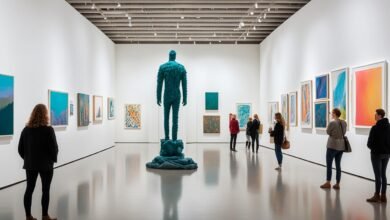Table of Contents
Paris is known as the city of love and art. It boasts some of the world’s most famous galleries.
You can see everything from ancient Egyptian pieces to stunning Renaissance paintings. These galleries show us the beauty and creativity of our world’s history.
As you walk through Paris, you may wonder about the top galleries. Which ones should you visit?
Ready for an art adventure in Paris? Let’s explore the best galleries together. You’ll see incredible works like the Mona Lisa.
Discover collections that tell stories over centuries and find amazing hidden gems. Are you excited to start your journey into the art world? Let’s go!
The Louvre: A Masterpiece of Art
The Louvre Museum was once a palace, making its architecture stand out. It inspired other grand designs like the U.S. Capitol and the Metropolitan Museum. The museum’s art collection includes everything from Egyptian artifacts to famous pieces like the Winged Victory of Samothrace.
Visiting the Louvre is a journey through art history. You’ll see art from ancient times to our modern era. It’s a place that shows off our creative spirit over the ages.
Architectural Marvel: Louvre Palace
Originally, the Louvre was a fortress. But over time, it became a beautiful royal home. Its mix of Renaissance and Classical styles is showcased in its courtyard and detailed facades.
A World of Art: Louvre Museum
Today, this former palace is home to the Louvre Museum. This museum in Paris has over 38,000 pieces of art. It takes you on a global journey through human creativity. You can see everything from Egyptian treasures to famous Renaissance paintings.
There are eight special departments in the museum. Each one focuses on a type of art. You can see stunning sculptures and beautiful Islamic artifacts. The museum also has a special department for paintings, including the famous Mona Lisa.
The Louvre is more than just a museum. It’s a place that shows the power and beauty of art. Millions of people come here for inspiration and to learn about our rich artistic history.
Code of Hammurabi: Ancient Legal Text
The Louvre Museum is famous for its art collection. It houses an amazing artifact from the ancient Near East: the Code of Hammurabi. This text is engraved on a 7.4-foot basalt stele. It gives a deep look into the legal system of the time.
“*When Marduk sent me to rule over humanity, to give the protection of right to the land, I did right and righteousness in Code of Hammurabi, ancient Near East, and brought about the well-being of the oppressed.*” – King Hammurabi
The Code of Hammurabi has laws for many parts of life. This includes criminal justice, family issues, property, and business. It’s one of the first written legal codes. It shows how advanced the legal systems were in ancient times.
One important part is the “an eye for an eye” law. It means punishments match the crimes. You see this in many of the criminal laws in the code.
The Discovery and Significance
In 1901, French archaeologists found the Code in what’s now Iran. It was part of ancient Mesopotamia. The stele was found in great condition and has careful engravings.
This stele has the longest and best-preserved legal text from the ancient Near East. Finding it gave us a lot of knowledge about ancient laws, society, and culture.
Today, people can see the Code in the Louvre Museum. It’s a powerful reminder of how ancient societies influenced our laws today.
| Key Features of the Code of Hammurabi | Implications |
|---|---|
| Criminal laws | Established a system of justice with prescribed punishments for various crimes. |
| Family laws | Outlined regulations governing marriage, divorce, and inheritance. |
| Property laws | Provided guidelines for property ownership, contracts, and disputes. |
| Commercial laws | Regulated trade, business transactions, and professional conduct. |
The Code’s mix of laws and regulations tells us a lot about the ancient world’s administration.
Exploring the Code of Hammurabi at the Louvre Museum allows you to journey through time and appreciate the foundations of legal systems that have shaped human civilization.
Winged Victory of Samothrace: A Symbol of Beauty
The Louvre Museum houses some of the world’s finest art, including the famous Winged Victory of Samothrace. This stunning marble statue is over 8 feet tall and portrays Nike, the Greek goddess of victory. Although it’s missing its head and arms, the beauty of its wings and stance is still captivating. It represents the Hellenistic art style from ancient Greece very well.
This statue was found in 1863 on the island of Samothrace by French archaeologist Charles Champoiseau. It’s thought to have been made in the 2nd century BC to honor a naval victory. Since then, it has stood for triumph and beauty.
Today, the Winged Victory of Samothrace is a highlight at the Louvre. It’s displayed in a special place where people from all over come to admire it. The statue impresses everyone with its design and skillful creation.
The Story Behind the Winged Victory of Samothrace
“Of all the works of art which I have seen in different lands, none have astonished me more than this.”
The Winged Victory of Samothrace’s origin and full meaning are still a bit of a mystery. But its beauty and impact are clear to all who see it. Its pose, like it’s mid-flight, captures a feeling of movement and elegance.
The statue stands on a base shaped like a ship’s prow, enhancing its symbolism. This design hints at the link between victory and the sea, and it suggests movement. The sculptor surely was very skillful at giving a story to stone.
Found in pieces, the statue’s missing parts only add to its mystery. Yet, even without its head and arms, the Winged Victory of Samothrace is still enchanting. It inspires and fascinates those who study it.
Appreciating the Winged Victory of Samothrace
When you see the Winged Victory of Samothrace at the Louvre, it feels like you’re in ancient Greece. Take time to study its detailed wings and the robes that look like they’re moving. Every aspect of this art piece speaks of triumph.
This artwork makes us think about ancient Greece, victory, and everlasting beauty. The Winged Victory of Samothrace shows the talent of Greek sculptors and the timeless charm of the Louvre.
Venus de Milo: Timeless Beauty
The Louvre Museum holds many famous works, including the Venus de Milo. This beautiful marble statue shows Venus, the goddess of love. Even without her arms, this statue is a sign of beauty that people all over the world love.
In 1820, the Venus de Milo was found on Milos island in Greece. It was given to King Louis XIII and ended up in the Louvre Museum. Its graceful pose and fine details have made it a favorite in classical art.
Looking at the Venus de Milo, you can’t miss its detailed clothing. The sculptor showed the goddess’s beauty and elegance perfectly.
“The Venus de Milo is the best of classical art, showing ancient Greece’s love of beauty. Even without arms, it is full of grace.” – Art critic
The Venus de Milo is now a symbol of the Louvre. Many people say it’s one of the top works of art in the world. It still touches hearts today.
There are many other ancient Greek works in the Louvre besides the Venus de Milo. All these pieces teach us about Greece’s rich history and culture.
Ancient Greece: A Legacy of Artistic Excellence
Ancient Greece is famous for its art, like sculptures and buildings. The pieces they made are still admired today. The Louvre’s collection lets us see the amazing skill of these ancient artists.
Every part of their art shows their love for beauty and detail. This reflects Greece’s long-lasting impact on art and culture.
Exploring the Louvre’s ancient Greek art helps us understand their artistic achievements. It shows the true value of their works.
The Coronation of Napoleon: Historical Splendor
The Louvre Museum holds a large painting by Jacques-Louis David. It shows Napoleon being crowned as Emperor. The scene shines with luxury and significance.
David carefully crafted every figure to show its importance. This painting underlines Napoleon’s rule and the big moment of his crowning. It is a snapshot of a crucial part of history.
The painting throws you into 19th-century France. Its details and colors whisk you away, letting you see the grandness of that historical moment.
This work is key in the Louvre, thanks to David’s skill. It indefinitely marks the event in our memories, showing the power of art.
When you visit the Louvre, don’t miss seeing this painting. It will carry you back to that special moment in time, making you appreciate Napoleon’s Coronation.
Liberty Leading the People: Symbol of Freedom
At the Louvre Museum, you can see Liberty Leading the People by Eugene Delacroix. It’s a powerful painting about the French Revolution and freedom. This artwork stands out for its beauty and the strong message it delivers.
In the painting, Liberty is a woman without a shirt, leading people in a fight for their freedom. Delacroix used bold colors and strong strokes to show the urgency of their cause. His work makes you feel the passion in the scene.
“Liberty Leading the People perfectly embodies the spirit of the French Revolution and celebrates the triumph of the people in their quest for liberty and equality.”
Today, this painting is a key symbol of Liberty and the French values. It reminds us of the importance of coming together for freedom.
It’s a big draw at the Louvre, bringing in visitors from all over. They come to see its beauty and its message about the past.
Visiting the Louvre’s Liberty Leading the People
When you’re at the Louvre, don’t miss Liberty Leading the People. It’s in Gallery 77, Department of Paintings. Placed in a prime spot, it’s a must-see.
Stand in front of the painting. Let its colors and scenes inspire you. You will see Liberty leading people from different backgrounds. This will make you think about how much we all want freedom around the world.
The Horse Tamers: Equestrian Elegance
The Louvre Museum houses a stunning pair of marble statues, named The Horse Tamers. Created in a time full of equestrian art mastery, these sculptures are breathtaking. They show horses with their grooms in a very lifelike way.
These statues used to be in the Château de Marly, a royal spot in Marly-le-Roi, France. Later, they were taken to the Louvre Museum, where they are kept safe and shown. Even now, people can see copies of the statues at the Château de Marly.
The effect of The Horse Tamers on the art world is huge. They have inspired many artists and art collectors. Their place in art history, included with other great horse sculptures, shows their importance in fine art.
The Horse Tamers’ Key Details
| Name | Location | Artist | Date |
|---|---|---|---|
| The Horse Tamers | Louvre Museum, Paris | Guillaume Coustou | 1739-1745 |
| Horse Tamers Castings | Château de Marly, Marly-le-Roi | Guillaume Coustou | 18th century |
The Horse Tamers show a beautiful bond between humans and horses. They are a highlight for anyone visiting the Louvre Museum. People from all over the world come to see and appreciate these elegant, ageless works of art.
The Seated Scribe: Ancient Egyptian Writing
In the Louvre Museum, there’s a special sculpture called The Seated Scribe. It shows a scribe working while sitting. This gives us a peek into writing and life in Ancient Egypt. The statue is well-kept and full of details, making it very interesting to look at.
This depiction is big in ancient Egypt. It shows how much their artists paid attention to details. The scribe sits straight on the floor, his legs crossed, showing he’s deeply focused. He wears a simple outfit and a head covering, much like others in ancient Egypt.
The sculpture is known for its true-to-life look. The artist did an amazing job with features like the scribe’s eyes and lips. The body looks just right, showing how well the artist knew about the human body. This statue gives a clear image of what scribes in ancient Egypt might have been like.
Ancient Egyptian Writing and the Role of Scribes
In ancient Egypt, writing with hieroglyphics was common. It was used for many things, from religion to daily life. Scribes were very important. They wrote down and kept important facts. This included things about religion, government, and special events.
Scribes were very smart and trained hard to write well. They worked in different places like the government or religious temples. The statue shows just how needed scribes were.
Seeing this statue in the Louvre Museum shows how much ancient Egyptian writing and art mean. By looking at it, people learn more about the past and what life was like back then.
“The Seated Scribe shows us ancient Egypt, where writing was key. It shows how important scribes were in keeping their society smart and knowledgeable.”
Visiting the Louvre lets you explore the wonders of ancient cultures. The Seated Scribe is one of many amazing pieces in the museum. It shows how rich and interesting the past can be for us.
| Key Information | |
|---|---|
| Date | Approximately 2500 BCE |
| Material | Limestone with inlaid rock crystal for the eyes |
| Dimensions | Height: 53.7 cm (21.1 in) |
| Location | Louvre Museum, Paris, France |
The Lacemaker: Meticulous Craftsmanship
Experience the 17th-century world through Johannes Vermeer’s famous painting, The Lacemaker. This piece, found in the Louvre Museum, shows how people crafted things with great care back then. It lets us peek into their daily lives.
In this painting, Vermeer shows a young girl working on her lace. The details are incredible. You can see the small patterns of the lace and how the girl carefully works with her hands.
Vermeer painted this scene with great skill. The room seems lit by gentle sunlight. He used light and shadow to give the painting depth. The lace looks like you could touch it.
This artwork is more than just Vermeer’s skill. It tells us about the work and hobbies of that time. The girl in the painting is fully focused. Her work shows how important craft was, and how much effort it took to be good at it.
When you see The Lacemaker in the Louvre, you’ll be amazed. It turns a simple moment into something special. Vermeer’s love for detail and his praise of everyday beauty truly shine in this work.
Gabrielle d’Estrées and one of her sisters: Intimate Portraiture
Gabrielle d’Estrées and one of her sisters are featured in a painting from the late 16th century. This masterpiece hangs in the Louvre Museum. It shows Gabrielle, who was King Henry IV of France’s enchanting mistress, with her sister.
The artwork reveals the women in a mysterious and playful pose. Viewers are left to guess at their bond and family dynamics. The intricate details hint at Gabrielle’s pregnancy, deepening the painting’s mystery.
“Portraiture lets us peek into past lives and hearts. The painting of Gabrielle d’Estrées and her sister shows the beauty and complexity of human ties. It sparks our interest and imagination.”
Highly regarded for its realism and use of light and shadow, the piece showcases the period’s portrait painting expertise. It is a true display of the artist’s skill.
When at the Louvre Museum, this stunning painting reminds us of art’s timeless ability to reflect our shared humanity.
The Legacy of Gabrielle d’Estrées
Gabrielle d’Estrées was a key figure in the late 16th century. She was the mistress of King Henry IV, a position that gave her significant power and influence. Her role is remembered fondly by historians and art fans, as seen in the Louvre’s collection.
The Turkish Bath: Oriental Fantasy
The Turkish Bath is a work of art by Jean-Auguste-Dominique Ingres, now in the Louvre Museum. It was painted in the 19th century. This masterpiece takes us to a world filled with sensuality and exotic visuals.
This painting shows a scene in a harem, with women who are naked. It reflects how the West was deeply intrigued by the East. Ingres pays close attention to each woman’s details and skillfully paints their bodies.
The work gives us a peek into the fantasies and views of that era. Ingres explores unique and exotic themes through his art. It highlights the lasting charm of Eastern dreams in Western art.






